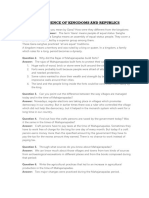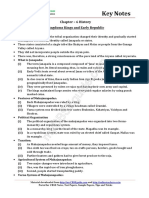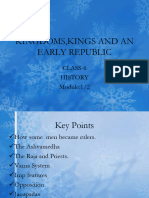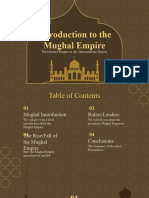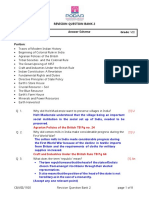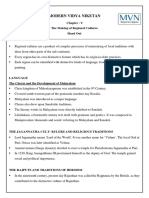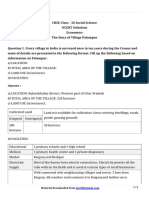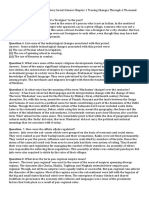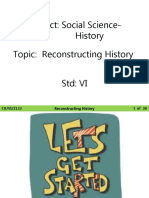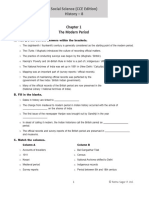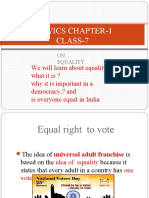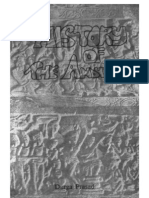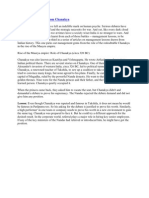Class 7 SST Chapter 5
Uploaded by
sourav.course299Class 7 SST Chapter 5
Uploaded by
sourav.course2995
CHAPTER
The Rise of Empires
There cannot be a country without people and there is
no kingdom without a country.
Kauṭilya in Arthaśhāstra
Fig. 5.1. Rock-cut cave in Barabar Hills, Bihar
The Big 1. What is an empire?
Questions 2. How did empires rise and shape
5 – The Rise of Empires
Indian civilisation?
Tapestry of the Past
3. What factors facilitated the
transition from kingdoms to
empires?
4. What was life like from the 6th
to the 2nd century BCE? 83
Chapter 5.indd 83 08-04-2025 12:48:21
Exploring Society: India and Beyond | Grade 7 Part 1
Fig. 5.2. An artistic representation of Paṭaliputra,
located around modern-day Patna
84
Chapter 5.indd 84 08-04-2025 12:48:23
Bhavisha and Dhruv were thrilled;
they had just activated their new
device, ‘Itihāsa’, a time machine
to travel to the past! Taking a clue
from their history lesson, they
decided to visit Pāṭaliputra for
their first journey — they knew it
was about the same location as
modern-day Patna.
5 – The Rise of Empires
Tapestry of the Past
85
Chapter 5.indd 85 08-04-2025 12:48:25
Landing on the outskirts of the great city, a little dizzy, they saw a
girl talking to a person on horseback dressed in strange clothes.
As he left, she turned to them, and they asked her for her name.
“My name is Ira, daughter of Kanhadas, the ironsmith. Welcome
to Pāṭaliputra!”
“Glad to meet you, Ira. Our names are Bhavisha and Dhruv.”
“Sshh! Keep your voices down! Do you see those soldiers marching
past? They’re heading to battle against a neighbouring kingdom
that has been troubling us. Our king avoids war when he can, but
he also protects his people when needed. My father helped forge
many of the swords they carry, and my uncle is one of the soldiers
in the group. I just came to see him off… I don’t know when he’ll
return.”
(The group watches as an
impressive procession of soldiers
crosses a sturdy drawbridge
leading out of the city, some on
horseback and the army chiefs
on elephant back. Then, the
three children cross the same
drawbridge to enter the city.)
“What kind of bridge is this?”
asked Bhavisha. “And is it a
Exploring Society: India and Beyond | Grade 7 Part 1
river below?”
“This bridge keeps us safe,”
Fig. 5.3 explained Ira. “It’s lifted
whenever there is a danger of attack on the city. And no, it’s not
a river, it’s a moat; once the drawbridge is lifted, it makes it more
difficult to approach the fortifications. Can you see those hills and
forests in the distance? They provide us with timber, herbs, and
many other valuable resources. Elephants for the army are also
captured from the forest and trained for the army.”
“What is the opening in that hill?” asked Dhruv.
“It’s a cave. Our king is getting it carved out for a community of
monks. I hope we can visit it when it’s finished!”
86
Chapter 5.indd 86 08-04-2025 12:48:25
(As they move through Pāṭaliputra, they take in its Tributary:
splendour — towering wooden ramparts with watch towers, A tributary,
in our case,
majestic palaces and buildings, lively streets. Ira gestures towards is a ruler
a bustling market filled with traders from distant lands.) or a state
that has
“You must visit our main market before you leave! Our king submitted to
welcomes travellers from all over, so you’ll get silk from China, an emperor
and pays
spices and gems from the south, fine clothes from different tribute—
regions—there’s nothing you won’t find in Pāṭaliputra!” that is,
money, gold
“What are those people over there doing?” asked Dhruv. (or other
precious
“Oh, these are street acrobats; they build human pyramids, sing metals),
and dance, or act in short plays to entertain people. Sometimes, grain,
livestock,
they perform in front of the king!” elephants
or other
“Your king sounds very powerful,” remarked Bhavisha. “Does he
valuable
rule the region around Pāṭaliputra?” goods
produced
“Much more than that!” answered Ira. “He rules over a vast land, in their
far, far beyond this city. His authority extends over many villages, kingdom and
is given to
towns and kingdoms. My uncle told me that it takes close to two
the emperor
months on horseback to reach the borders of the territory!” as a sign of
submission,
“That sounds bigger than just a kingdom… What do you call it?” loyalty or
respect. A
“It is called an Empire,” Ira stated with evident pride.
synonym for
‘tributary’ is
What is an Empire? ‘vassal’, and
another way
The word ‘empire’ comes from the Latin ‘imperium’, which to express
this is to
means ‘supreme power’. Simply put, an empire is a collection say that the
of smaller kingdoms or territories over which a powerful ruler tributary
or vassal
or group of rulers exert power, often after waging war against kingdoms
the smaller kingdoms. The smaller territories still had their own accepted the
rulers, but they were all tributaries to the emperor, who ruled emperor’s
overlordship.
the whole territory from a capital, usually a major centre of
5 – The Rise of Empires
economic and administrative power.
Tapestry of the Past
In ancient Sanskrit texts, words commonly used for ‘emperor’
made this clear; they included samrāj, meaning ‘the lord of all’
or ‘supreme ruler’; adhirāja or ‘overlord’; and rājādhirāja or
‘king of kings’.
87
Chapter 5.indd 87 08-04-2025 12:48:26
Indian history is full of empires. They rose, expanded, lasted
for a while, declined, and disappeared. In fact, the last empire
that ruled the Subcontinent existed less than a century ago! But
now is not the time to tell that story; we start at the other end
of time, so we may understand how empires functioned in the
distant past and how they deeply impacted India’s evolution at
all levels — political, economic, social, and cultural.
Features of an empire
01
Maintains an army
to keep the tributary
states under control,
expand the empire
06 or protect it from 02
Maintains outside aggression
Designs and maintains
communication an administration, with
networks (roads, river officials to manage
and sea navigation) and the territories, collect
other infrastructure taxes, maintain law
for administration, Emperor and order, etc.
trade and people’s exerts central
welfare authority over
the empire's
05 tributary 03
territories and
Exploring Society: India and Beyond | Grade 7 Part 1
kings
Makes laws, issues
Encourages art, currencies, weights
literature, religions, and measures,
schools of thought, regulates trade
04
centres of learning
Controls and
regulates access
to resources
(mines, forest and
agricultural produce,
manpower)
88
Chapter 5.indd 88 08-04-2025 12:48:26
LET’S EXPLORE
Æ Empires extended over vast areas and had diverse people
with differing languages, customs and cultures. How
do you think the emperors made sure that they lived in
harmony? Discuss in groups and share your thoughts with
the class.
Æ Looking at the many challenges involved in managing
an empire, why should a king be so keen to expand his
kingdom into an empire and become an emperor? Here
are a few possible answers; see if you can think of a few
more:
An ambition to ‘rule the entire world’, a metaphor
for controlling large territories and ensuring that
Posterity: The
they would be remembered for posterity; generations to
come.
A wish to bring large areas under control and gain
access to their resources to build economic and
military strength;
A desire for great wealth for himself and for the
empire.
In return for tribute and loyalty, emperors generally allowed
regional kings or chiefs to continue to govern their areas.
Fig. 5.4.1. Trained
armies were
deployed to conquer
neighbouring
5 – The Rise of Empires
kingdoms, maintain
Tapestry of the Past
control over them and
defend the empire’s
borders.
89
Chapter 5.indd 89 08-04-2025 12:48:27
Fig. 5.4.2. Fortified settlements
would be built in strategic
places, such as the empire’s
borders.
Fig. 5.4.3. To expand into an
empire, a kingdom might
first wage war against
neighbouring territories so as
to conquer them.
Fig. 5.4.4. Rulers endeavoured
to control rivers and trade
networks as that would give
them control over precious
Exploring Society: India and Beyond | Grade 7 Part 1
resources, apart from tax
revenue from the trade.
Fig. 5.4.5. With many smaller
kingdoms warring for control,
the one with access to stronger
military power and surplus
resources would eventually
become the overlord.
90
Chapter 5.indd 90 08-04-2025 12:48:30
LET’S EXPLORE
Warfare apart, what other methods do you think the rulers
might have used to expand their empires? Pen your ideas and
share them with your class.
Trade, trade routes and guilds
Conducting military campaigns, especially in distant lands, is
not as simple as it might seem. Maintaining an army is a costly
affair: soldiers need to be fed, clothed, equipped with weapons,
and paid; elephants and horses need to be cared for; roads or
ships have to be built, and so on. All this requires considerable
economic power, control over the workforce, and access
to resources.
We can now understand that economic activity — especially
production and trade — is one of the keys to maintaining an
empire and ensuring people’s welfare and quality of life, which
a good ruler should be concerned with. Therefore, establishing
and controlling trade routes all over the empire’s territory
and beyond is of great importance. That way, the goods traded
will grow in quantity and variety, and more trade means more
income for the producers and increased tax collections for
the ruler.
Returning to the case of ancient India, what would have been the
traded goods? There is plenty of evidence on this, at least, both
from the literature and archaeological excavations — textiles,
spices, agricultural produce, luxury items such as gems and
handicraft products, and various animals were among the main
items of trade. All this brisk trade was not limited to India; many
Indian goods travelled towards distant countries by land or sea.
5 – The Rise of Empires
More often than not, traders were not just isolated individuals
Tapestry of the Past
carrying out their own business. They soon understood
the benefits of joining forces and creating guilds (śhrenīs).
Guilds were powerful associations of traders, craftsmen,
moneylenders or agriculturists. As far as evidence shows,
a guild had a head (who was usually elected) and executive
91
Chapter 5.indd 91 08-04-2025 12:48:30
officers who were supposed to have all kinds of ethical qualities.
Two things made traders’ guilds a remarkable institution. First,
they brought together people who ended up being collaborators
Takṣhaśhilā
Śhibipura
Hastināpura
Śhrāvastī
Vaiśhālī
Mathurā
Kāśhī Pātaliputra Prāgjyotiṣhapura
Champā
Kauśhāmbi
Rājagṛiha
Dvāraka
Ujjayinī
Tāmralipti
Bharukachchha
Sopārā Kalinganagara
Pratiṣhṭhāna
Exploring Society: India and Beyond | Grade 7 Part 1
Suvarnagiri
Kānchīpura
Kāverīpattinam
Muchiri
Madurai
Fig. 5.5. Some important trade routes from about 500 BCE onward and major
92 cities marked on them. Notice the Uttarapatha and the Dakṣhiṇapatha routes.
Chapter 5.indd 92 08-04-2025 12:48:31
rather than competitors, as they realised that sharing resources
and information on markets, supply and demand, workforce,
etc., was to everyone’s benefit. Second, as an ancient text put
it, “Cultivators, traders, herdsmen, moneylenders, and artisans
have authority to lay down rules for their respective classes”;
in other words, guilds had the autonomy to create their own
internal rules, and the king was not to interfere with them (and
why should he, if trade flourished?).
Guilds spread over large parts of India and endured for centuries.
Even after they ceased to exist formally, their spirit continued
to influence India’s trade and business activities, sometimes
even to this day. The institution of guilds provides an excellent
example of the self-organising abilities of Indian society. The
ancient village unit, with its various committees and councils,
provides another. Indeed, an enlightened ruler would let people
organise themselves and refrain from interfering if the local
institutions worked satisfactorily.
LET’S EXPLORE
Æ Observe the map of the trade routes. Identify geographical
features that helped the traders travel across the
Subcontinent.
Æ What modes of transport on those roads do you think were
available at the time?
The Rise of Magadha
The period between the 6th and the 4th century BCE was
one of profound change in north India. We briefly visited the
sixteen mahājanapadas earlier — those large kingdoms of north
and central India with their assembly system. One of them,
5 – The Rise of Empires
Tapestry of the Past
Magadha (modern-day south Bihar and some adjoining areas),
rose in importance and set the stage for the fusion of many
kingdoms into India’s first empire. Powerful early kings, such as
Ajātaśhatru, played a crucial role in establishing Magadha as a
dominant centre of power.
93
Chapter 5.indd 93 08-04-2025 12:48:31
DON’T MISS OUT
Two of the most famed religious figures of the
world — Siddhārtha Gautama, who became known as the
Buddha, and Vardhamānan, better known as Mahāvīra — lived
in the time of King Ajātaśhatru. Revisit their teachings in the
Grade 6 textbook’s ‘India’s Cultural Roots’ chapter.
Magadha was located in the resource-rich Ganga plains, with
fertile land, abundant forests for timber, and elephants. Also,
remember how the use of iron transformed other technologies,
such as agriculture and warfare. Iron ore and other minerals
from the nearby hilly regions proved crucial for the expansion
of the kingdom. The use of iron ploughs to till the land increased
agricultural produce, and lighter and sharper iron weapons
strengthened the capabilities of the army.
Exploring Society: India and Beyond | Grade 7 Part 1
Fig. 5.6. An elaborate panel from the Sanchi Stūpa depicting soldiers riding elephants, horses, or
on foot, waging battle and laying siege to Kusinārā (today Kushinagar), a city of north India, to
recover relics of the Buddha (seen carried away on an elephant in the left part of the panel).
LET’S EXPLORE
Æ Take a close look at the panel given above. How many
types of weapons can you identify? What different uses
of iron can you make out?
Æ In the left part of the panel, a parasol (chhattra) is kept
over the casket containing the Buddha’s relics. Why do
you think this was done?
94
Chapter 5.indd 94 08-04-2025 12:48:32
The production of surplus
food grains allowed more
people to focus on the arts
and crafts, which were in
demand inside and outside the
empire’s borders. The Ganga
and Son rivers provided a
geographical advantage for
trade, as they could be used for Fig. 5.7. A punch-marked silver coin of
transportation. The flourishing Mahāpadma Nanda
trade boosted the empire’s
income and contributed to Magadha’s rise.
Around the 5th century BCE, Mahāpadma Nanda rose to
prominence in Magadha and founded the Nanda dynasty. He
successfully unified many smaller kingdoms and extended
his empire across parts of eastern and northern India. As the
economy thrived, he began issuing coins, demonstrating his
economic power. We also learn from Greek accounts that the
Sūtras:
Nanda dynasty maintained a large army. Sutras are
concise,
From various accounts of the Nanda dynasty, it appears that its carefully
last emperor, Dhana Nanda, though very rich, became highly crafted
phrases
unpopular as he oppressed and exploited his people. This paved
that capture
the way for the Nanda empire to be conquered and absorbed knowledge
into what would become one of the largest empires India ever and
important
knew — the Maurya empire. ideas (from
ancient
DON’T MISS OUT Indian text)
in a way
that’s easy
The famed Sanskrit grammarian to remember
Pāṇini lived around the 5th and pass on.
century BCE, during the time
5 – The Rise of Empires
of the Nandas. He is known for
Tapestry of the Past
composing the Aṣhṭādhyāyi, an
ancient text that lists the rules of
Sanskrit grammar in 3,996 short
Fig. 5.8. An India post stamp
sūtras. commemorating Pāṇini
95
Chapter 5.indd 95 08-04-2025 12:48:33
The Arrival of the Greeks
While events unfolded in Magadha, located in the eastern part
of the subcontinent, what was happening in the northwestern
region? This area was home to smaller kingdoms along an
ancient route connecting to the Mediterranean. Among them,
according to Greek accounts, were the Pauravas, led by their
king, Porus.
Granicus Guagamela
Pella
Issus
Hydaspes
Alexandria Susa
Babylon Persepolis
Memphis
Fig. 5.9
Exploring Society: India and Beyond | Grade 7 Part 1
334–331
BCE:
Alexander, a young and powerful Greek
king from Macedonia, campaigned
against the Persian Empire to avenge
earlier Persian invasions of Greece
(during which some Indian soldiers
from the Persian-ruled northwest of
India fought against Greeks!). Alexander
conquered the Persian Empire; the
influence of Greek culture spread. His
96 empire now spread over three continents,
Fig. 5.10 one of the largest in world history.
Chapter 5.indd 96 08-04-2025 12:48:38
DON’T MISS OUT
The satraps were governors of provinces of Persian and
Greek empires who were left behind by the overlord (like
Alexander) to manage the far-off territories. These satraps
had significant power and freedom despite being mere
officials of the rulers. Can you guess how it was possible for
them to exercise such power?
THINK ABOUT IT
Why do you think Alexander wanted to rule over the entire
world? What would he have gained from it?
LET’S EXPLORE
When, after the battle, Alexander asked Porus how he wished
to be treated, Porus answered, “Like a King.” Alexander then
left Porus at the head of his kingdom, as satrap. With the help
of your teachers, find more details on the battle between Porus
and Alexander. Enact a play of this battle scene using your
imagination in addition to what you have discovered.
Back in Persia, Alexander faced rebellions and
political turmoil. After he fell ill and died in
Babylon at the age of 32, his immense empire
was soon divided between his generals and the
satraps, who created their own kingdoms.
327–325 324–323
BCE BCE
5 – The Rise of Empires
Eager to reach the “end of the world”, Alexander pushed on
Tapestry of the Past
further east and brought his campaign to India, defeated Porus in
Punjab and, encountering fierce resistance from local tribes and
rulers, massacred the population of several cities. Greek records
mention that in a few battles, “women fought side by side with
their men.” Alexander himself was seriously wounded in a battle.
Tired and homesick, his soldiers lost the will to fight and refused
to move deeper into India, towards the Ganga River. Alexander
and part of his army retreated to Persia, but through the coastal
route in the south and Iran’s harsh desert regions, resulting in 97
heavy losses to his troops out of thirst, hunger and disease.
Chapter 5.indd 97 08-04-2025 12:48:39
Alexander’s dialogue with the Gymnosophists
Alexander heard of a group of Indian sages whom the Greeks
called ‘Gymnosophists’ or ‘naked philosophers’ (probably
because they wore very little clothing), who were renowned for
their wisdom. Alexander challenged them with tricky questions
in the form of riddles, warning that he would put those who
gave wrong answers to death. However, the Gymnosophists
responded to his questions calmly and intelligently. Alexander
was impressed and, in the end, spared them all. Over the
centuries, different versions of this story have been told, making
it one of the most fascinating encounters in history!
According to one account, Alexander
asked, “Which is stronger, life or
death?” One of the sages replied, “Life,
because it endures while death does
not.” Alexander then asked, “How can
a man be most loved?” “If he is most
powerful and yet does not inspire
fear,” came the reply, perhaps as a
hint to the mighty ruler!
Fig. 5.11. A Greek coin
probably showing Historians view such exchanges as
Alexander on horseback a meeting of two great traditions —
attacking Porus on his
elephant.
Greek and Indian philosophies.
Exploring Society: India and Beyond | Grade 7 Part 1
The Mighty Mauryas
After that brief sojourn to the northwest, let us return to
Magadha, where we witnessed the decline of the Nanda
empire. Around 321 BCE, just a few years after Alexander
left India with his army, a new dynasty and new empire
emerged: the Maurya Empire founded by Chandragupta
Maurya. It quickly absorbed the Nanda empire’s territories
and went on expanding beyond.
As per many accounts, Chandragupta managed this feat with the
help of an able mentor named Kauṭilya, who used his knowledge
of politics, governance and economics to create an empire that
98 remains one of the greatest in Indian history.
Chapter 5.indd 98 08-04-2025 12:48:39
The story of Kauṭilya
According to Buddhist texts, Kauṭilya—sometimes referred to as
Chāṇakya or Viṣhnugupta—was a teacher at the world-renowned
Takṣhaśhila (modern-day Taxila) university. His legendary tale
begins in the court of Dhana Nanda, who as we saw, had become
highly unpopular.
Indus
Ch
en
lum i ab
Jhe Ra
v
a s
Be
lej
Su
t ng
ha
Di
s
Mana
Mathurā
Ya
m Śhrāvastī Vaiśhālī
un
a Gha utra
map
Ga
Tis
gha
Brah
si
l ra
ng
ba
Ko
ta
a
am Vārāṇasī Pāṭaliputra
Ch
k
as
ra
Ban Champā
Kauśhāmbī
Ba
son
Rājagṛiha
a
tw
Ujjayinī Vidiśhā
Su
Be
i
ba
ah
rn
Narmada
M
Mahanadi Tāmralipti
ar
i
Tap
ek
Wainganga
Brah
ha
mani
l
God Te
ava
ri
Indravati
Bhi
ma
Kri
shn
a
ra
ad
a bh Penn
ng er
Tu
Pala
r
Pon
naiy
ar
5 – The Rise of Empires
Cau
Tapestry of the Past
ver
y
99
Fig. 5.12. Nanda Empire
Chapter 5.indd 99 10-Apr-25 10:46:26 AM
Indus
Pushkalavati Takṣhaśhilā (Taxila)
ab
m en
lu Ch vi
Jhe Ra
s
ea
Kāndhār B
e j
S utl
Sankissā
Ahichchhatra Kosi
nas
Ya
Śhrāvastī
Mathurā
Ma
m Gha Vaiśhālī
l una
Ga
Tis
a gha
mb ra
ng
ta
a
Ch Sārnāth Pāṭaliputra
k
as Kauśhāmbī
ra
Ban Champā
Ba
son Vāranasi
a
Rājagṛiha
tw
Ujjayinī Vidiśhā
Be
Su
i
ah
ba
Sānchi
Br
Narmada i
rn
M
Mahanadi Tāmralipti
ah
ar
Tap
ek
an
ha
l
i
God Te Tosālī
ava
ri
Pratiṣhṭhāna
Indravati Dhauli
Bh
im
Kr a
ish
na Amrāvati
Pen
Suvarnagiri ner
Cau Pala
ver r
y
Ker
Kolidom
ala
Cholas
put
s
ya
ras
nḍ
Exploring Society: India and Beyond | Grade 7 Part 1
Pā
Fig. 5.13. Maurya Empire
Observing this, Kauṭilya advised Dhana Nanda to change his
ways or witness the collapse of his empire. Angered, Dhana
Nanda insulted Kauṭilya and threw him out of his court. This led
to Kauṭilya’s vow to end the ‘evil Nanda’ rule.
The rise of Chandragupta Maurya
There are many stories about the origin and adventures of
100 Chandragupta Maurya, but their common theme is that he
Chapter 5.indd 100 08-04-2025 12:48:40
Fig. 5.14. Megasthenes in the court of Chandragupta Maurya
(A 20th-century painting by Asit Kumar Haldar)
overthrew the Nandas and took control of Magadha to establish
his rule, with Pāṭaliputra as his capital. Do you remember that
Magadha had many advantages because of its geography, an
established economic system and a flourishing trade? These,
combined with the advice of the master strategist, Kauṭilya,
helped Chandragupta Maurya gradually expand his empire.
He defeated the Greek satraps left behind by Alexander in
the northwest and integrated the region into an empire that
stretched from the northern plains to the Deccan plateau.
After Chandragupta Maurya defeated the Greeks, he maintained
a diplomatic relationship with them and hosted in his court a
Greek historian and diplomat, Megasthenes, who wrote about
his travels in India in his book Indika — the first such written
account — unfortunately lost except for some excerpts quoted
by later Greek scholars.
5 – The Rise of Empires
Tapestry of the Past
Kauṭilya’s concept of a kingdom
Kauṭilya had a clear vision of how a kingdom (rājya) should
be established, managed and consolidated. In his famous
work Arthaśhāstra (literally, ‘the science of governance and
economics’), he listed directives in many areas like defence, 101
Chapter 5.indd 101 08-04-2025 12:48:40
Kauṭilya’s Saptānga
the king (swāmi)
[the group of] councillors, the territory of the state
ministers and other high along with the population
officials (amātya) inhabiting it (janapada)
Exploring Society: India and Beyond | Grade 7 Part 1
the fortified towns and cities the treasury or the wealth of
(durga) the kingdom (koṣha)
the forces of defence and the allies (mitra)
law and order (daṇḍa), and
102 Fig. 5.15
Chapter 5.indd 102 08-04-2025 12:48:45
economics, administration, justice, urban planning, agriculture
and people’s welfare. One of his most important political concepts
is the saptānga (see fig 5.15) or the seven parts that constitute
a kingdom.
According to Kauṭilya, the saptānga together must create
a settled, well-protected, and prosperous kingdom to be
maintained both through warfare and through alliances for
peace, as the case may be. He emphasised the importance
of law and order in society, which necessitated a strong
administration. He also detailed many laws to deal with
corruption and specified punishments for any activities that
went against the wellbeing of the people.
THINK ABOUT IT
Kauṭilya says, “A king shall increase his power by
promoting the welfare of his people, for power comes
from the countryside which is the source of all economic
activity. [The king] shall show special favours to those in
the countryside who do things which benefit the people,
such as building embankments or road bridges, beautifying
villages, or helping to protect them.”
Why do you think it was important to take special care of
the countryside? (Hint: Think back to what you have learnt
at the beginning of this chapter)
Kauṭilya’s central philosophy of governance is in tune with
Indian values: “In the happiness of his subjects lies the king’s
happiness; in their welfare his welfare. He shall not consider
as good only that which pleases him but treat as beneficial
to him whatever pleases his subjects.” In other words,
5 – The Rise of Empires
however powerful a king may be, he must give first place to the
Tapestry of the Past
people’s interests.
LET’S EXPLORE
Organise a group discussion in your class and compare the
features of Kauṭilya’s idea of an empire with a modern nation.
103
Chapter 5.indd 103 08-04-2025 12:48:45
The King Who Chose Peace
Another king of the Maurya
dynasty was Aśhoka (268–
232 BCE), Chandragupta’s
grandson, who came to
be credited with major
administrative and religious
achievements.
At the beginning of his
reign, Aśhoka was quite
ambitious. He had inherited
a vast empire but further
expanded it to cover almost
the entirety of the Indian
subcontinent, except for
the southernmost region,
Fig. 5.16. Aśhoka visiting the Ramagrama stūpa in
Nepal (from a panel at the Sānchi stūpa) but including present-day
Bangladesh and Pakistan
and parts of present-day Afghanistan. One encounter, however,
Edict:
An official is said to have changed the path of his life. According to one of
declaration his edicts he once marched on Kalinga (modern-day Odisha),
issued by
where he waged a ferocious war. Seeing the enormous amount
authorities
or, in our of death and destruction on the battlefield, Aśhoka chose to
case, a king. give up violence and, to the greatest extent possible, adopt the
Exploring Society: India and Beyond | Grade 7 Part 1
path of peace and non-violence that the Buddha taught.
THINK ABOUT IT
Aśhoka, in his edicts, tells the story of the Kalinga war. He
could have chosen not to mention it and maintain his image
Emissary: as a peaceful, benevolent king for future generations. Why
Someone do you think he admitted to this destructive war?
sent on
a special
mission, Embracing Buddhist teachings, Aśhoka sent emissaries to
often of a Sri Lanka, Thailand, Central Asia and beyond to spread the
diplomatic
nature. message of the Buddha far and wide.
104
Chapter 5.indd 104 08-04-2025 12:48:45
Historians have sometimes called Aśhoka
We have referred to the
a ‘great communicator’ since he issued in
Prakrit language written in
many parts of his empire edicts engraved on
Brahmi script. What does
rocks or pillars that contained his messages
this mean? Very simply, a
for the people and encouraged them to
language is what we speak,
follow dharma. Most of these edicts were
while script is what we write
inscribed in Prakrit, which was the popular
a language in. Can you think
language in many parts of India and written
of examples of this in our
in the Brahmi script (Brahmi is the mother
everyday life?
of all regional scripts of India).
Mansehra
Kandahar Kalsi
Meerut
Lumbini
Bairat
Kaushambi Barabar hills
Sarnath
Girnar Sanchi
Dhauli
Amravati
Maski
Brahmagiri
5 – The Rise of Empires
Tapestry of the Past
Fig. 5.17. A few of the many Aśhokan edicts across the Subcontinent 105
Chapter 5.indd 105 08-04-2025 12:48:46
In his edicts, Aśhoka called himself ‘Devanampiya Piyadasi’;
the first word means ‘Beloved of the Gods’; the second, ‘one
who regards others with kindness’. And indeed, the language
of the edicts makes it clear that he was interested in depicting
himself as a benevolent and compassionate ruler. Let us see a
few examples of this.
Although some southern kingdoms were not part of the Mauryan
kingdom, Aśhoka supported their overall wellbeing. He claimed
to provide medical care for people and animals even beyond his
Fig. 5.18. (Left) A reproduction of a part of Aśhoka’s rock edict at Girnar,
Gujarat. (Right) Detail of the Topra Aśhokan pillar at Feroz Shah Kotla, Delhi
Exploring Society: India and Beyond | Grade 7 Part 1
empire, prohibited hunting and cruelty to animals, and ordered
medical treatment for them when necessary. If so, Aśhoka
was an early contributor to nature conservation and wildlife
preservation. He said he had established rest houses and wells
at regular intervals along the main roads of his empire and got
fruit and shade trees planted. He also claimed to encourage all
sects (the different schools of thought present in his time) to
accept each other’s best teachings and study them.
Although we need not take all of Aśhoka’s claims literally, it is
clear that in line with Kauṭilya’s philosophy of governance, he
paid attention to the welfare of his subjects and made efforts to
106 reach out to them.
Chapter 5.indd 106 08-04-2025 12:48:47
DON’T MISS OUT
You read about the word ‘dharma’ (dhamma in Prakrit) in
Grade 6. Its essence cannot be easily captured. In simple
terms, dharma means moral law or someone’s religious or
ethical duties towards family, community or country. At a
deeper level, however, dharma extends to living according
to the order of the universe or ṛitam. This includes doing
one’s duty truthfully, following rules of righteous conduct
and leading a life in harmony with the cosmic order.
Dharma is, therefore, duty, law, truth, order and ethics — all
of it together!
LET’S EXPLORE
Aśhoka details instructions on the conduct of his officials and
mentions ways to ensure that they practised fairness in one of
his edicts. Read the translation below and share your thoughts
on whether those ways would have been successful in helping
manage his empire and how.
“By order of the Beloved of the Gods — the officers and city
magistrates [...] are to be instructed thus:
[…] You are in charge of many thousands of living beings. You
should gain the affection of men. All men are my children,
and just as I desire for my children that they should obtain
welfare and happiness both in this world and the next, the
same do I desire for all men. […] You should strive to practice
impartiality. […] The root of all this is to be even-tempered
and not rash in your work. […] This inscription has been
engraved here in order that the city magistrates should at
5 – The Rise of Empires
all times see to it that men are never imprisoned or tortured
Tapestry of the Past
without good reason. […] And for this purpose, I shall send
out on tour every five years, an officer who is not severe or
harsh; who, having investigated this matter..., shall see that
they carry out my instructions.”
107
Chapter 5.indd 107 08-04-2025 12:48:47
The Maurya empire continued for half a century after Aśhoka’s
death. However, his successors were unable to hold the empire
together, and many of the smaller kingdoms broke off and
became independent. Around 185 BCE, India started on another
phase of her journey. Bhavisha and Dhruv will join us on this
journey in the next chapter.
Life in the Mauryan period
Cities like Pāṭaliputra were bustling centres of governance and
commerce. They had palaces, public buildings, and well-planned
streets. With a well-organised taxation system and brisk trade,
the treasury remained strong, fuelling the empire’s growth
and prosperity. Officials of the administration of the empire,
merchants and artisans played key roles in the city life.
DON’T MISS OUT
The Sohagaura copper
plate inscription, dating
back to the 4th–3rd
century BCE, is one of
India’s earliest known
administrative records.
Discovered in Sohgaura,
Exploring Society: India and Beyond | Grade 7 Part 1
Uttar Pradesh, it is written Fig. 5.19
in Prakrit using the Brahmi script and is believed to have
been issued during the reign of Chandragupta Maurya. The
inscription mentions the establishment of a granary to store
grain as a precaution against famines, highlighting the state’s
efforts to ensure food security and support its people during
times of crisis.
Megasthenes’ account also throws some light on the society
of that time. A substantial proportion of the population was
engaged in agriculture, which was an important source of
revenue for the empire. Two crops were sown in a year, as rain
108
fell in both summer and winter. This ensured that famines were
Chapter 5.indd 108 08-04-2025 12:48:47
rare and people had ample food. Granaries were well stocked
for any eventualities. Even if war raged nearby, farmers were
protected from it, and agriculture was not disturbed.
Blacksmiths, potters, carpenters, jewellers and other artisans
lived in the cities. The cities were well-planned and had signage
on the streets. Communication happened through couriers who
carried messages from place to place. The houses were made of
wood and could be up to two storeys tall. The streets had vessels
of water stored at regular intervals in case of fire.
Later accounts describe the cotton dresses people wore — a
lower garment that reached below the knee halfway down to
the ankles and an upper garment that they threw over their
shoulders. Some wore leather shoes with designs and thick soles
to make them look taller.
LET’S EXPLORE
Wear the hat of a historian. Look carefully at the artefacts
presented on the spread on the next page. What conclusions
can you draw about people and life during the Mauryan era?
Fig. 5.20 has many messages for us,
apart from the beauty and perfection
of the sculpture, and is a fine example
of Mauryan art. This capital (a word
which, here, means ‘top portion’ or
‘head’) was the top of a pillar that
Aśhoka got erected at Sarnath, near
Varanasi, where the Buddha gave
his first teaching. The four lions
symbolise the royal power; on the
ring below, four powerful animals
5 – The Rise of Empires
Tapestry of the Past
(an elephant, a bull, a horse and
one more lion) are depicted, along
with the dharmachakra or wheel
Fig. 5.20. The Mauryas were
of dharma, which symbolises the renowned for their highly
Buddha’s teachings. polished stone pillars, as can
be seen in this capital of the
Sarnath pillar. 109
Chapter 5.indd 109 08-04-2025 12:48:47
Some Contributions of the Mauryas
Life and people
Fig. 5.21. Terracotta figurine of a Fig. 5.22. Terracotta figurine
dancing girl (notice her elaborate of a female deity.
headdress, hairstyle and jewellery).
Exploring Society: India and Beyond | Grade 7 Part 1
Fig. 5.23. Female deity (yakshī) holding a fly whisk.
Fig. 5.24. Terracotta of Saptamātrikās or seven Fig. 5.25. Head of a terracotta
mother goddesses (a continuing tradition). horse (notice the elaborate
110 design of the bridle).
Chapter 5.indd 110 08-04-2025 12:48:49
Art and architecture
Fig. 5.26. As one of India’s oldest stone structures, the Great Stūpa at Sanchi is among
the finest examples of Indian architecture. Note that the original structure was made
of bricks and was later enlarged using stone. Aśhoka is said to have constructed
many such stūpas, chaityas, and vihāras for worship, study, and meditation.
5 – The Rise of Empires
Tapestry of the Past
Fig. 5.27. Rock sculpture of a life-size elephant at Dhauli (in present-day Odisha,
near Bhubaneswar), which symbolises the Buddha — intelligent, powerful, patient,
and calm. An edict of Aśhoka was engraved on a rock nearby.
111
Chapter 5.indd 111 08-04-2025 12:48:51
This image may be familiar to some of you. Indeed, this
capital was chosen as India’s national emblem, to which was
added the Sanskrit motto satyameva jayate or “truth alone
triumphs” (see the national emblem on the left). Besides,
the dharmachakra is depicted at the centre of our national
flag, as you may also have noticed. The motto comes from
the Muṇḍaka Upaniṣhad; in full, it reads satyameva jayate
Fig. 5.28 nānṛitam, that is, “truth alone triumphs, not falsehood”.
LET’S EXPLORE
Notice the different symbols on the coins. Can you guess
what any of the symbols in the coins below might mean?
Fig. 5.29.1. A hoard of Mauryan punch-marked coins,
Fig. 5.29.2. A punch-marked coin of Aśhoka
DON’T MISS OUT
Exploring Society: India and Beyond | Grade 7 Part 1
The big, round hemispherical structure in the centre of the
stūpa is called the aṇḍa. It represents the universe and is often
built to house sacred relics. People walk around it in a circle
as a form of worship (pradakṣhiṇa).
The Fragile Nature of Empires
You will hear in higher grades about past mighty empires
elsewhere in the world, such as the Roman, the Persian, the
Ottoman, the Spanish, the Russian, the British empires, and so
on. All of them are long gone, but historians keep debating the
causes of their decline.
112
Chapter 5.indd 112 08-04-2025 12:48:51
One of those causes, as we saw, is the temptation for some of
the empire’s regions to try and become independent. This could
happen if, for example, the emperor needed more resources
for long military campaigns or in times of drought; local rulers
would be burdened with increasing demands for tribute,
leading to resentment. Or if a powerful emperor was followed
by one perceived to be weak, local kings or chieftains might
simply decide to take a chance and stop paying tribute. Also, the
larger an empire, the more difficult it is to hold it together, as
Alexander experienced; far-off territories are often the first to
split away from the empire. Finally, economic crises caused by
natural calamities (such as a long drought or floods) could also
shake an empire’s structure.
Empires are, therefore, something of a paradox. On the one hand,
they can bring about political unity, as the Mauryan empire
did to almost the entire Subcontinent, and reduce or eliminate
warfare among the smaller kingdoms — indeed, a well-managed
empire could lead to greater prosperity than smaller, warring
kingdoms. On the other hand, empires have almost always been
established through war and have maintained their existence
Mahāpadma Chandragupta
Nanda Maurya
Ajātaśhatru
Aśhoka
5 – The Rise of Empires
600 500 400 321 300 200 185 100
Tapestry of the Past
BCE BCE BCE BCE BCE BCE BCE BCE
Mahājanapadas Nandas Mauryas
Fig. 5.30 113
Chapter 5.indd 113 08-04-2025 12:48:52
through force and repression. This makes them fragile at their
core and unstable over time.
Before we move on …
Æ An empire is a large territory made up of many smaller
kingdoms or territories. Emperors expanded their kingdoms
mostly to gain fame, amass power, including military power,
and control resources and economic life.
Æ The first empires of India emerged in regions blessed
with abundant natural resources, rivers for irrigation and
transport, and the production of a variety of goods for trade.
Æ Alexander’s campaign in northwest India had a limited
political impact but opened the door for Indo-Greek cultural
contacts.
Æ The Mauryas created a vast empire with a legacy that lasted
centuries. Their legacy includes strengthening trade routes
and economic systems, extensive use of coins for trade,
well-designed urban settlements, and an elaborate system
of administration. They also promoted art and architecture.
Æ Aśhoka was keen to advertise his achievements and project
the image of a benevolent ruler who encouraged his subjects
to follow dharma.
Questions and activities
Exploring Society: India and Beyond | Grade 7 Part 1
1. What are the features of an empire, and how is it different
from a kingdom? Explain.
2. What are some important factors for the transition from
kingdoms to empires?
3. Alexander is considered an important king in the history of
the world —why do you think that is so?
4. In early Indian history, the Mauryas are considered
important. State your reasons.
5. What were some of Kauṭilya’s key ideas? Which ones of
these can you observe even today in the world around us?
114
Chapter 5.indd 114 08-04-2025 12:48:52
6. What were the unusual things about Aśhoka and his empire?
What of that has continued to influence India and why? Write
your opinion in about 250 words.
7. Thus speaks the Beloved of the Gods, the king Piyadasi: My
officers of Dhamma are busy in many matters of public benefit,
they are busy among members of all sects, both ascetics and
householders. I have appointed some to concern themselves
with the Buddhist Order, with brahmans and Ājīvika..., with the
Jains..., and with various sects. There are many categories of
officers with a variety of duties, but my officers of Dhamma are
busy with the affairs of these and other sects.
After reading the above edict of Aśhoka, do you think he was
tolerant towards other religious beliefs and schools of thought?
Share your opinion in the classroom.
8. The Brahmi script was a writing system that was widely used
in ancient India. Try to learn more about this script, taking
help from your teacher wherever required. Create a small
project and include what you have learnt about Brahmi.
9. Suppose you had to travel from Kauśhāmbī to Kāveripattanam
in the 3rd century BCE. How would you undertake this journey,
and how long would you expect it to take, with reasonable
halts on the way?
5 – The Rise of Empires
Tapestry of the Past
115
Chapter 5.indd 115 08-04-2025 12:48:52
Chapter 5.indd 116
Exploring Society: India and Beyond | Grade 7 Part 1
116
08-04-2025 12:48:52
You might also like
- On CH 5 The Rise of Empires For Class VIINo ratings yetOn CH 5 The Rise of Empires For Class VII59 pages
- Notes of Chapter 8 Devotional Paths To Divine Class 7th HistoryNo ratings yetNotes of Chapter 8 Devotional Paths To Divine Class 7th History5 pages
- Class 7th - History - Chapter - NEW KINGS AND KINGDOMS100% (1)Class 7th - History - Chapter - NEW KINGS AND KINGDOMS25 pages
- CBSE Class 7 Social Science Our Past 2 Chapter 8 Devotional Path To The Devine Important Questions 2023-24No ratings yetCBSE Class 7 Social Science Our Past 2 Chapter 8 Devotional Path To The Devine Important Questions 2023-245 pages
- Devotional Paths To The Divine Class 7 Ncert NotesNo ratings yetDevotional Paths To The Divine Class 7 Ncert Notes10 pages
- 06 Social Science History Key Notes Ch06 Kingdoms Kings and and Early RepublicNo ratings yet06 Social Science History Key Notes Ch06 Kingdoms Kings and and Early Republic2 pages
- Ch-2-Reshaping India's Political Map - QAs - Class 8100% (1)Ch-2-Reshaping India's Political Map - QAs - Class 85 pages
- GR - 6 Revision Worksheet India PhysicalNo ratings yetGR - 6 Revision Worksheet India Physical1 page
- Vi His L05 M01 Kings Kingdoms and Early Republics PPTNo ratings yetVi His L05 M01 Kings Kingdoms and Early Republics PPT15 pages
- Class 7 History NCERT Solution Chapter 1 Introduction Tracing Changes Through A Thousand YearsNo ratings yetClass 7 History NCERT Solution Chapter 1 Introduction Tracing Changes Through A Thousand Years31 pages
- T1429614515iworksheet S-ST Class 8th SolutionNo ratings yetT1429614515iworksheet S-ST Class 8th Solution84 pages
- Revision Question Bank 2 Subject: Social Science Answer Scheme Grade: VIIINo ratings yetRevision Question Bank 2 Subject: Social Science Answer Scheme Grade: VIII8 pages
- 9 Ncert Solutions Soc Sci Eco The Story of Village PalampurNo ratings yet9 Ncert Solutions Soc Sci Eco The Story of Village Palampur5 pages
- Geography Chapter - (Human Resources) Class 8No ratings yetGeography Chapter - (Human Resources) Class 85 pages
- Class 7 SS History Chapter 4 Fundament Questions PDFNo ratings yetClass 7 SS History Chapter 4 Fundament Questions PDF11 pages
- Class 7 History Chapter 1 NCERT SolutionsNo ratings yetClass 7 History Chapter 1 NCERT Solutions4 pages
- Class Viii - Social Science - History LN 6 The Great Uprising Notes RS PublicationNo ratings yetClass Viii - Social Science - History LN 6 The Great Uprising Notes RS Publication3 pages
- 6 - (JAN) S - SC - L-11 THE GUPTA & THE POST-GUPTA PERIOD (H) - NOTES - PRIYA - JNo ratings yet6 - (JAN) S - SC - L-11 THE GUPTA & THE POST-GUPTA PERIOD (H) - NOTES - PRIYA - J4 pages
- History Ch1 The Revelation of Medieval IndiaNo ratings yetHistory Ch1 The Revelation of Medieval India4 pages
- Chapter 4 New Beginnings - Cities and StatesNo ratings yetChapter 4 New Beginnings - Cities and States2 pages
- The Making of The National Movement: 1870-1947: History Class Viii Chapter - 9 Unit Iv0% (1)The Making of The National Movement: 1870-1947: History Class Viii Chapter - 9 Unit Iv25 pages
- Ashoka - The Emperor Who Gave Up War: Class - 6 History Lesson - 7No ratings yetAshoka - The Emperor Who Gave Up War: Class - 6 History Lesson - 724 pages
- NCERT Solutions For Class 7 History Chapter 4 The Mughal EmpireNo ratings yetNCERT Solutions For Class 7 History Chapter 4 The Mughal Empire4 pages
- (04a) Wielding The Rod of Punishment - War and Violence in The Political Science of KautilyaNo ratings yet(04a) Wielding The Rod of Punishment - War and Violence in The Political Science of Kautilya14 pages
- Folk Dances, Dynasties, Fair & FestivalsNo ratings yetFolk Dances, Dynasties, Fair & Festivals18 pages
- Life and Achievements of Chandragupta MauryaNo ratings yetLife and Achievements of Chandragupta Maurya2 pages
- Project and Notes On The Mauryan DynastyNo ratings yetProject and Notes On The Mauryan Dynasty19 pages
- Bihar History English Hunkar Lyst1732905456083No ratings yetBihar History English Hunkar Lyst173290545608326 pages
- L5 - Mauryan Empire 321 BC 184 BC - 1679056951No ratings yetL5 - Mauryan Empire 321 BC 184 BC - 167905695184 pages
- TO Ministry of Culture Government of India: Submission For Classical Status of Marathi LanguageNo ratings yetTO Ministry of Culture Government of India: Submission For Classical Status of Marathi Language237 pages









